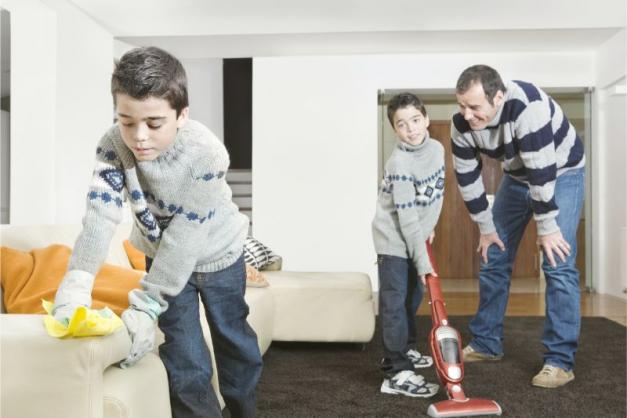Share

Family life runs more smoothly when there is a shared responsibility for the housework. Whether it's a simple effort like putting dirty clothes in the hamper or a major job like washing the kitchen floor, almost every family member can contribute in some way that fits his/her age and other responsibilities.
Everyone in the family can find a way to pitch in and make doing the housework easier and less of a one-person chore, regardless of experience level.
Here Is a Basic Cleaning Guide:
Practice Prevention
- Keep clutter to a minimum. Having lots of stuff around makes cleaning harder and gives places for dust and allergens to collect.
- Wash hands with soap and warm water regularly - to help stay healthy and keep dirt and germs off household surfaces.
- Wipe shoes on entryway rugs or mats to protect floors and carpets, and to catch dirt, dust, pollen and other allergens brought in from the outside.
- Keep bathroom and kitchen surfaces as dry and clean as possible to help control the growth of moisture-loving bacteria, mold and mildew.
- Leave shower doors and curtains open after use so shower walls can air-dry.
- Treat spots and stains on garments and clothes as soon as they occur.
- Promptly clean up crumbs and other food scraps after preparing or eating food.
- Wipe up spills before they have a chance to dry.
- Put coasters under beverage glasses to prevent water spots and rings on wood surfaces.
Give Priority to the Important Jobs
- Clean and disinfect cutting boards and kitchen countertops before and after preparing food to help reduce the threat of foodborne illness.
- Disinfect sink areas, toilet bowls, tubs and showers to kill germs as well as mold and mildew that can trigger asthma attacks.
- Launder sheets weekly in warm or hot water to remove dust mite allergens and keep linens fresh.
- Wash towels and bathmats once a week.
- Dust hard furniture regularly using a dusting product.
- Vacuum carpets and mop wood floors once a week.
Follow Tips from the Experts
When doing the laundry,
- Check clothing care labels to see how the manufacturer recommends caring for the garment.
- Match the wash cycle and water level to the load.
- Separate colors from whites (to keep dyes from bleeding onto lighter-colored fabrics) and heavily soiled items from lightly soiled ones.
- Use the recommended amount of detergent per load. Adjust the amount of detergent if soil, water or machine conditions are not average.
In the bathroom,
- To fight mildew in the shower, clean stalls and bathtubs using a non-abrasive, all-purpose or disinfectant (antibacterial) cleaner. Check the label to find out if the product kills germs and/or mildew, and follow directions for best results.
- To get rid of the "ring around the bathtub," use a soap scum remover.
- Use a daily shower spray on walls and shower curtains to keep mildew from growing.
- Clean vinyl or ceramic tile using a floor cleaner or a non-abrasive, all-purpose cleaner.
Tackling kitchen surfaces,
- Use a disinfectant (antibacterial) cleaner to clean countertops and kill bacteria that may be found in raw meat, poultry or fish.
- Clean refrigerator walls and shelves using a nonabrasive, all-purpose cleaner or a solution of baking soda and water.
- Sweep or vacuum the floor first, then mop starting at the farthest corner of the room and working your way toward the exit. Use a cleaner that's right for your floor type.
- Use an abrasive cleanser for hard-to-remove soils like food particles and grease residues in sinks. Read the label first to see whether the cleaner is recommended for the finish.
In a hurry? Check out our Efficient Home Cleaning Guide.